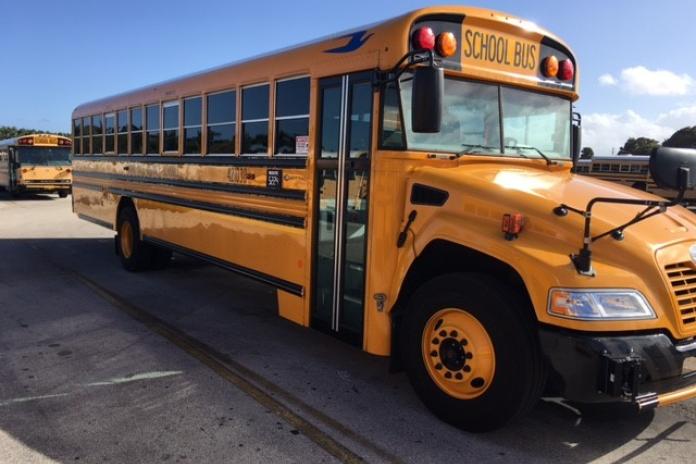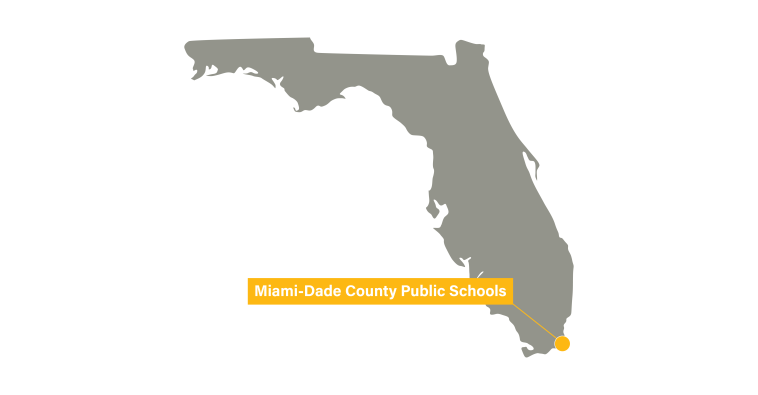How a South Florida School District Is Using Electric School Buses to Advance District Sustainability
The Miami-Dade County Public Schools district has plans to reach 100% clean energy by 2030. Electric school buses form a centerpiece of its broader sustainability strategy.

Miami-Dade County is the seventh-most populous county in the U.S. and the third-largest public school district in the country. It's one of the largest public-school districts in the nation to incorporate electric school buses (ESBs) in its fleet.
Electric school buses play a key role in the district's larger sustainability planning. In 2022, Miami-Dade County Public Schools (M-DCPS) released its “Clean Energy 2030 Report,” which marked the first significant step in its overall sustainability strategy. Electric school buses form a central piece of the school district’s proposed transportation strategy, which aims to replace 999 diesel-burning buses with quieter, cleaner electric buses.

Since 2023, the school district has added 85 ESBs, 35 of which are in daily operation today and another 50 that will be in operation starting in the 2025-2026 school year. Adding these buses was made possible through funding from the Environmental Protection Agency’s Clean School Bus Program (CSBP) as well as the Volkswagen Mitigation Settlement Trust Fund.
"Electrifying our fleet is one of the most visible climate actions we’ve taken—and it dovetails perfectly with energy-efficiency upgrades, our SolarTogether partnerships, and the districtwide goal of reducing energy use 15% by 2026."
- Karly Pulido, Sustainability Officer at M-DCPS
Why Miami-Dade chose electric school buses
There was broad community enthusiasm for adding electric school buses to the district’s fleet, especially given cost-saving and improved health outcomes. “We knew cutting emissions and fuel costs while improving student health was a win-win,” said Karly Pulido, Sustainability Officer at M-DCPS. The district’s long routes make fuel savings and tailpipe elimination especially urgent in the Miami area. Each diesel bus consumes about 11 gallons of fuel per trip, which adds up to approximately 1,980 gallons over a school year—fuel that can be completely eliminated for every single school bus that transitions to electric.
| Miami-Dade County Public Schools | |
| Location | Miami, Florida |
| Number of students | ~340,000 students |
| Number of students riding the bus | 51,000 students, or 15% |
| Fleet size | ~1,000 school buses |
| Number of electric school buses in fleet | 85 electric school buses |
The changing climate in South Florida also impacted planning for the electric charging infrastructure. “We had to consider temperature increases, making sure that our charging can actually withstand certain temperatures, what to do with extreme wind, with hurricanes, how we're going to elevate the charging when there is flooding,” among other climate impacts, Pulido explained.
The Clean Energy 2030 Report was critical in kick-starting the school district’s electric school bus rollout as well as other sustainability initiatives. The report demonstrated “that first major foundational step in how the district is really moving forward with sustainability now and in the future … that helped create the narrative of where we are going … that ultimately got us funded,” she said.
"Our electric buses are performing exceptionally well, even in South Florida’s extreme heat. The air conditioning systems are keeping students comfortable, and we’re already seeing a reduction in operational costs."
- James Hicks, administrative director of transportation for M-DCPS
Miami-Dade’s sustainability planning
The path to the Clean Energy 2030 report began in April 2021, after the M-DCPS School Board unanimously voted to adopt a resolution to get the school district to 100% clean energy by 2030. The school board created a task force to develop the Clean Energy 2030 Report, which included several recommendations and policy changes such as renewable energy, energy conservation and stewardship, waste, transportation and others.
Electric school buses are “central” to the overall sustainability planning of the school district, Pulido said. “Electrifying our fleet is one of the most visible climate actions we’ve taken—and it dovetails perfectly with energy-efficiency upgrades, our SolarTogether partnerships, and the districtwide goal of reducing energy use 15% by 2026,” she emphasized.
The Clean Energy 2030 report also outlines the benefit of using ESBs as a vehicle-to-building (V2B) solution to provide power to infrastructure such as hurricane shelters in the case of extreme weather events. Although the district has yet to pursue further opportunities in that space, Pulido emphasized that “the future of electric school buses is using it as a powerhouse and not only a transportation device … [the] resiliency and the capacity of those large batteries should be tapped into.”
Transportation is the district’s third-largest source of greenhouse gas emissions, making the sector a key focus of the report, which highlighted reducing bus idling time, increasing carpooling rates and other measures. The top priority of the transportation strategy is replacing diesel-burning buses with “quiet, clean, electric vehicles [that] will provide a safer and healthier ride for students and will improve air quality in high-pollution corridors where underserved communities are disproportionately exposed to health risks.”
M-DCPS chose to deploy the ESBs on shorter routes of 50 to 60 miles in economically disadvantaged neighborhoods. Initially, the district prioritized shorter routes due to range anxiety, but as confidence in the technology grew, they found they could muscle longer routes with ease. Pulido noted that all of the CSBP-funded electric schools buses are on routes servicing Title I schools, which are those that receive supplemental financial assistance from the U.S. Department of Education for serving children from low-income families.
"The future of electric school buses is using it as a powerhouse and not only a transportation device … [the] resiliency and the capacity of those large batteries should be tapped into."
- Karly Pulido, Sustainability Officer at M-DCPS
Partners and Advocates
M-DCPS has worked with a wide variety of stakeholders and community partners to shape its broader sustainability planning and help guide the federal grant applications.
“It takes a whole village,” Pulido said when asked about the partnerships that helped form the district’s electric school bus program. Referring to funding opportunities like the CSBP, she added that “these grants are not easily won and having thought partners … is extremely important.” Collaborations ranged from thought partnership with the Cleo Institute, to support letters from Dream in Green, to implementation support for the district’s ESB program from Miami-Dade County. M-DCPS also partners with Florida Power and Light (FPL), having enrolled in the local electric utility’s community solar program, SolarTogether, which powers two of the ESB depots.
Pulido emphasized how more creative public-private partnerships will be needed to help the district reach its goal of replacing 999 diesel-burning buses with ESBs by 2030. The Foundation for New Education Initiatives helps fund the M-DCPS educational programs, ranging from summer internship programs to the technology-focused STEAM program. Pulido noted that the school district aims to drive impact by leveraging the Foundation’s Green Fund to foster relationships with private partners and pursue fundraising opportunities.
What’s the latest?
The school district has found the community to be very supportive. Interacting with the “new, efficient, environmentally friendly buses has generated positive engagement from students, parents and local residents,” Pulido said.
“Our electric buses are performing exceptionally well, even in South Florida’s extreme heat. The air conditioning systems are keeping students comfortable, and we’re already seeing a reduction in operational costs, especially in fuel and maintenance compared to our diesel fleet,” added James Hicks, administrative director of transportation for M-DCPS. “Just as importantly, they’re contributing to improved air quality around our schools, which directly benefits student health and well-being.”
M-DCPS has received over $36 million in federal awards and has tripled its electric fleet since 2023. This funding includes $19.75 million from the EPA’s Clean School Bus Program—$8.8 million through the rebate program and $7.7 million from the Clean Heavy-Duty Vehicles program. The district expects to receive an additional 50 ESBs through CSBP funding in the summer of 2025, and those will be operational for the upcoming 2025-26 school year.
Advice for other school districts
“Data is crucial,” Pulido said, advising other districts to “start with data, build with people, and lead with purpose.” Through tools like EnergyCAP, the school district has been able to get real-time access to energy usage across schools, helping to identify inefficiencies, track savings, and make a stronger case for future investments into clean, energy-efficient technologies.